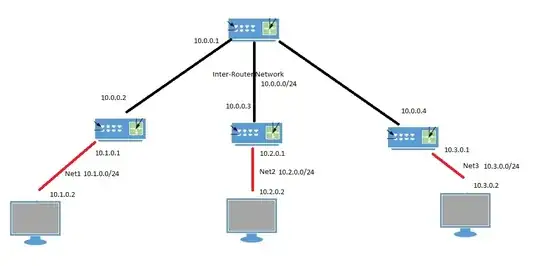I think you've fundamentally misunderstood how routers work. You may be trying to utilize routers as switches which is unnecessary. In which case, you'd only need 1 router and three 'vlans' on it with three ports leading off to the PCs or a switch for multiple PCs.
If you do actually need multiple routers, you'd want one 'inter router network' and three 'client' networks. See diagram below:

Edit: I just realized my diagram is very similar to yours. I think the problem may be that you're mixing up subnet masks inside the 'client' networks. The Net1 subnet mask should be consistent between the router interface and client, e.g. both should be 255.255.255.0 in my example.
Edit2: Oh I see what you're doing. You're using a commercial integrated hub/router and misunderstanding the way the WAN/LAN ports work. The WAN port is the only "router" port on a WRT54G. The LAN ports only act as a switch/hub. There would be no way for you route from a LAN port. The top level router would need to have multiple WAN ports with each of the lower ports connected to it. The WAN port acts "external" to the LAN ports because it's on the opposite side of the 'router' portion of the device.
Edit3: This may be an XY problem. If you're just trying to make a big network for a LAN party, the easiest thing would be to run a cable from a LAN port on each device to another. Then they all share the same 'network'. Disable DHCP on all but one of the 'routers' so that they don't conflict with each other.
Edit4: If you really want to do the routing thing, connect the WAN ports of the two "Lower" routers to the LAN ports of the "upper" router. The 'upper' router will give DHCP assignments to the WAN interfaces of the lower routers and the clients can connect to the "lower" routers with a different IP space. The "upper" router WAN port can be connected to internet.
